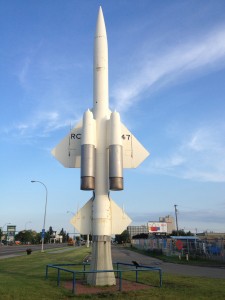
UPDATE: New Information on BOMARC as Interim ABM
Publicly derided and quietly phased out in 1972, the Coffin Interceptor Missile 99B/W40 Weapons System Mod 0, better known as the BOMARC, has faded into-near obscurity in Canadian history. Of the 56 BOMARC airframes deployed to Canada in the early 1960s, three remain on public display in Canada. The bronze plaque on one of them stationed outside the Edmonton airport states: “In 1971 the BOMARC missile was abandoned. Although the BOMARC was nuclear warhead capable, it was a great disappointment for Canadian forces to fulfill Canada’s role in the North American Air Defence (NORAD) Command.” Similarly, the data supplied at the Canadian Aviation and Space Museum in Ottawa states “While on paper the missile looked impressive, the BOMARC was not able to intercept long range nuclear-armed missiles that began to be deployed at the beginning of the 1960s.”
Any perusal of political cartoons from the period readily uncovers numerous caustic sketches usually depicting an unflattering caricature of Prime Minister John Diefenbaker juxtaposed with the missile in some fashion. Then there were the professional critics: these included members of the nascent anti-nuclear movement in Canada who wanted Canadian neutrality in the Cold War. There were opposition politicians looking for any angle from which to attack the government. There were armed forces personnel engaged in inter-service politics. Less publicly, there was a serious personnel failure at 447 Squadron, the BOMARC unit at LaMacaza, which almost resulted in the removal of the warheads in 1964.
Historiographically, the BOMARC becomes the easily-targeted scapegoat for the close-out of the now mythic CF-105 Arrow programme. No book dealing with the Arrow programme gives the BOMARC system any positive ink in any way, shape, or form. Arrow is Canadian, BOMARC is American. Arrow good, BOMARC bad. There is no quarter. The BOMARC had to be bad so that the Arrow can be so good.
Yet, despite the odds, Canada’s two BOMARC squadrons quietly remained on guard for a decade, ready to engage Soviet bomber aircraft in the event of an attack North America. This begs the question: if the system was so flawed, why did it stay in service so long? Was it simply a matter of bureaucratic or political inertia? Was it really as technological flawed or as strategic obsolete as asserted at the time in the public domain?
However, there were aspects of the BOMARC system itself, and in particular the warhead that it carried, that suggests there may have been other factors in play. Given the levels of secrecy that existed at the time, and possibly even today, those aspects have not emerged in any coherent form. This article will examine the hypothesis that the BOMARC missile system could have had applications as an interim or expedient Anti-Ballistic Missile system. The evidence is not definitive. It is circumstantial. It is an intriguing hypothesis. Indeed, this potential capability remained in the American domain because of the close-hold aspects of nuclear weapon design and employment.